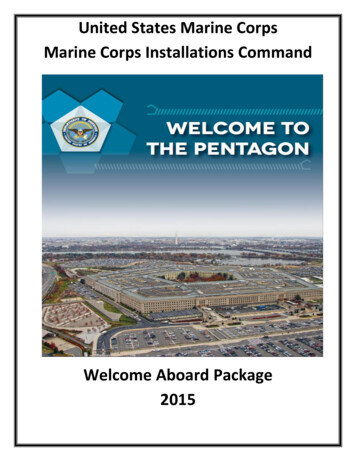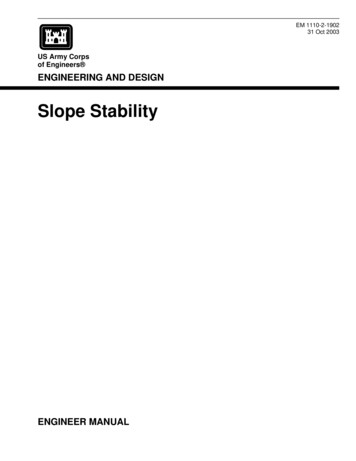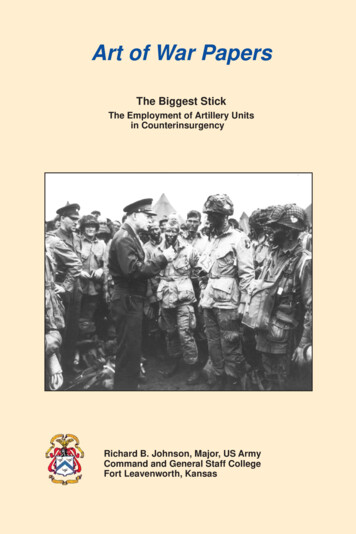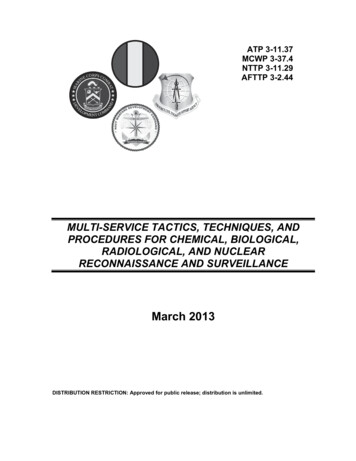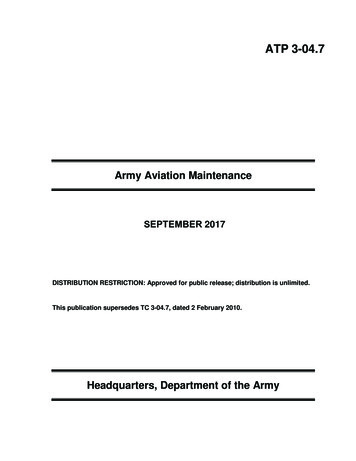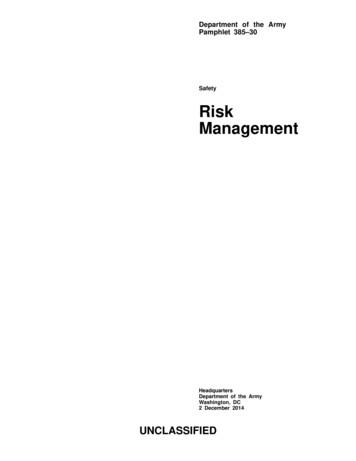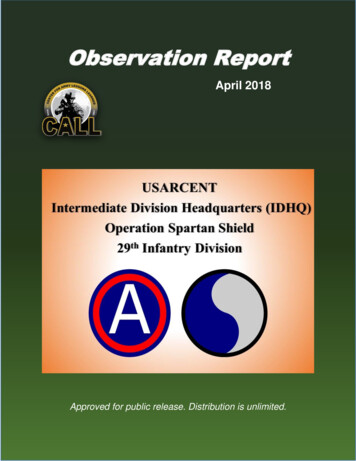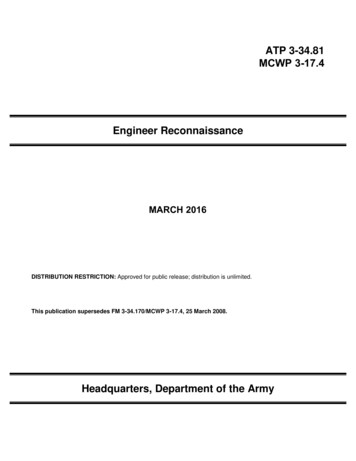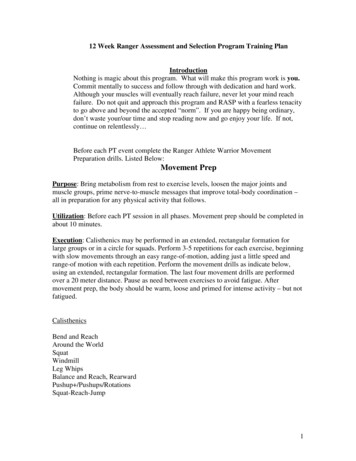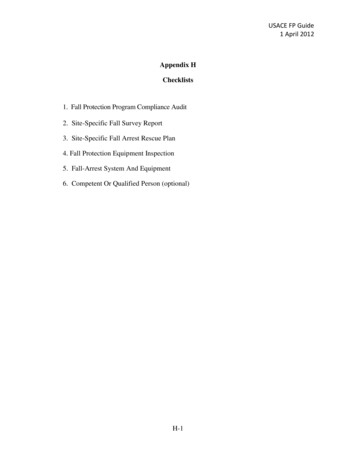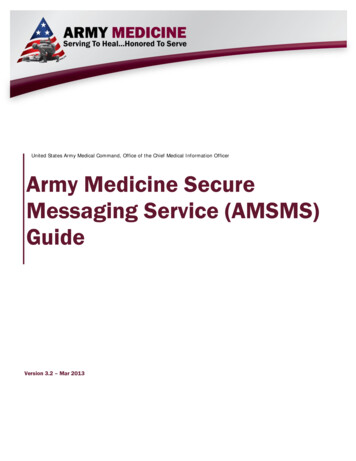
Transcription
United States Army Medical Command, Office of the Chief Medical Information OfficerArmy Medicine SecureMessaging Service (AMSMS)GuideVersion 3.2 – Mar 2013
Army Medicine Secure Messaging Service (AMSMS) GuideDocument HistoryVer.DateDescription of ChangeStatusDocumentOwner1.0Oct 11ReleaseFinalBPM2 DraftMar 12added Comments Par. 4.3.2UpdateBPMDraftMar 12Appendix D - Changed to Sample AMSMSStandard Operating ProcedureAddedBPMDraftMar 12Appendix E- Detailed Message WorkflowsChangeBPMDraftMar 12Appendix F – Documenting SecureMessaging Encounters in AHLTAAddedBPM2.0Apr 12FinalReleaseBPM3 DraftJun 12Added/modified text in paragraph's 4.3,4.4, 4.7, 4.8, & 6.4UpdateTASM/CM/BPM/STSDraftJun 12Updated the following verbiage throughoutdocument:- “SuperUser” to “Clinic Administrator,”- “Army Medical Home” to “Army PCMH”- “Secure Messaging” to AMSMS”- “text message” to “secure message”UpdateTASM/CM/BPM/STSDraftJun 12Updated Workflow diagrams & removedAlt workflowUpdateBPMDraftJun 12Added Appendix on Sustainment TrainingUpdateSTS3.0Jun 12FinalReleaseBPM3.1Jul 12Updates to sections 4.4, 4.5 and 4.8UpdateTASM/CM3.2Mar 13Added 2.5UpdateBPM3.2Mar 13Add to Note on 4.2UpdateBPM3.2Mar 13Added note 4.8 Additional GuidelinesUpdateBPM3.2Mar 13Updated Workflow diagrams W/BPVAUpdateBPM3.2Mar 13Added Chronic Disease comment toLesson’s learned2
3.2Mar 13Separated Appendices from GuideUpdateBPM3
Army Medicine Secure Messaging Service Executive SummaryThe AMEDD is deploying the Army Medicine Secure Messaging Service (AMSMS), powered by RelayHealth. TheAMSMS is a robust package of functionality that supports the Army Patient Centered Medical Home (PCMH) model ofhealthcare delivery and the joint principles of Accountable Care Organization.Patients can contact their clinic using any of seven message types. These incoming messages are divided intoadministrative messages and clinical messages. Administrative messages include new patient requests for access to system, requests for face-to-faceappointment, and notes to administrative staff.Clinical messages include note to provider, prescription renewal, lab/rad/test result request, and referralrequests.The clinic or provider can also initiate messages to their patients or send a broadcast message to one patient,a subset of patients, or the entire AMSMS enrolled beneficiary population.Recommended work flow: Incoming administrative messages will go to a common administrative in-boxIncoming clinical messages will go to a common clinical in-box that the practice will monitor multiple times adayOnce messages in these common in-boxes have been reviewed, they are either resolved or secondarilyforwarded to the appropriate team member for final disposition.AMSMS supports structured web encounters for adult health, children’s health, men’s health, women’s health, chronichealth concerns and others.Furthermore, the AMSMS supports HIPAA compliant secure messaging between team members and betweenproviders.There are five functional elements of the Army PCMH that are supported by the AMSMS: Access management can be improved through the ability to directly communicate with the healthcare team.Care coordination activities can be improved via secure communication between team members andproviders.Population health activities can be facilitated by sending out clinical preventive service reminders or diseasespecific education to patients. This outreach can further be supported through an extensive multi-mediapatient education library.Patient activation strategies will be enhanced through access to the extensive multi-media patient educationlibrary.Enhanced access is supported through the web visit functionality and the ability to request face-to-faceappointments directly from the medical home administrative support team.4
Table of ContentsArmy Medicine Secure Messaging Service Executive MSMS Overview3.158Administrative Patient Messages8Clinical Patient Messages93.1.3Colleague Messages103.1.4Broadcast Messages103.2Patient Education113.3Customizable Message Features123.4Other Features for Your Practice123.4.1Patient List123.4.2Preventive Care12Practice TypesMessage Workflow13144.1Preferred Primary Message Workflow144.2Preferred Secondary Message Workflow16Guidelines for AMSMS175.1Message Types175.2Response Time175.3783.1.15.2.16Messaging73.1.23.54Need Assistance?AMEDD Response StandardRequired EHR Documentation and Coding18185.3.1Provider Uses of Code 99444 for Online AMSMS185.3.2Non-physician Uses of Code 98969 for On-line Medical Evaluation195.4Patient Registration195.5Appointment Booking205.6Diagnostic Results215.7AMSMS “Rules of the Road”215.8Additional Guidelines22Security and Access246.1.1Provider and Staff Access246.1.2Patient Access24Decision Maker257.1Decision 1: Identify AMSMS Practice Members257.2Decision 2: Assign Member Rights257.3Decision 3: Decide Which Messages to Offer267.4Decision 4: Associate Message Types with Inboxes265
7.589Decision 5: Establish New Message Notifications26Technical Requirements288.1.1Internet -Up Blockers28Online Setup299.1Step 1: Accept Providers and Staff into Your Practice299.2Step 2: Establish Member Rights and Set Inbox Notifications299.3Step 3: Create Message Inboxes for Your Practice309.4Step 4: Establish Message Settings3110 Patient Enrollment3310.1Patient Benefits3310.2Additional Tips3411 Lessons Learned3612 Glossary38The AMSMS Guide Appendices are located at AMEDD Clinical Systems Exchange at the following URL:406
1 /RESOURCES/ACSE/Pages/default.aspxCongratulations! Now that your clinic has access to the AMSMS, you’ll find it easier to deliver high quality care – bymore efficiently addressing non-urgent issues and fostering closer relationships with your patients. In addition, theAMSMS improves continuity, coordination and comprehensiveness of care.The AMSMS is provided byBecause the AMSMS is accessed through a secure Internet site, there is no software to install. However, there are aseries of decisions to be made and steps to be followed before you begin using the service. Those decisions andsteps are outlined in this Guide, which is organized as follows:Service OverviewAn introduction to AMSMS, features, and terms. These sections also includemessage workflows, AMEDD-specific guidelines, and security and access features.Decision MakerOutlines the decisions an individual with an appropriate level of authority mustresolve before starting to use the AMSMS.Online SetupFollow these steps to finalize the setup of your service.Patient EnrollmentTips on promoting the AMSMS to your patients.Lessons LearnedTips on using the AMSMS from clinics already using the service.AppendicesAdditional information including detailed workflows, case studies, sampletemplate schedules, and training resources.GlossaryLook here to define any unfamiliar terms you encounter.2.1Need Assistance? For issues related to the website performance, Call the RelayHealth toll-free number and speak to one of theRelayHealth Customer Support representatives from 4:30 am to 5:00 pm Pacific Standard Time: 1-866RELAY-ME (1-866-735-2963), select option 1 or send a secure message x For issues related to Tier One Help Desk support, contact the USAMITC Enterprise Service Desk. System Change Request (SCR). Individual sites will contact USAMITIC Project Lead, (210) 808-2855, withany SCR to request changes to the vendor’s program functionality. If you have additional questions or concerns, please contact your Clinic or MTF POC who can contact theirRegional AMSMS POC, USAMITIC PM or RelayHealth as needed.7
3 AMSMS OverviewThis overview will introduce you to the features of the AMSMS. In this section, we’ll define the various AMSMSfeatures – including Messaging, Patient Education, Referrals, webVisit, and several additional service modules.The AMSMS is designed to address non-urgent medical questions – like medication refill requests or referrals – fromestablished patients. It is never appropriate for emergency or other time-critical issues. This is a statementcommunicated to patients frequently as they use the service and is also addressed in the Terms of Use (TOU) thatpatients must agree to when they register for the AMSMS. It can also be used to communicate with your patientsproactively using the Broadcast Message feature, described in detail below. 3.1This symbol tells you where to go for more information on a topic; typically, this additional information is detailed in acorresponding RelayHealth Feature Guide. The most recent copies of the Feature Guides, which are updated with each majorservice release (typically 3-4 times a year), are accessible from the Help section of the service. Just click the Help andTraining link at the upper right of any screen in AMSMS and select the Setup/Learning Tools tab.MessagingPatients may send your practice administrative messages (e.g., appointment requests) or clinical messages (e.g.,Note to Doctor and prescription renewal requests). You may customize certain aspects of a message, such as addinginstructions to patients on how to use a particular message type or how to have the service notify you when you havemessages waiting in an Inbox.3.1.1Administrative Patient MessagesAppointment Request: A message providingstructured fields in which the patient enters preferredappointment times. Patients may also use thismessage type to request to cancel or rescheduleexisting appointments. Your practice can quickly andeasily initialize automatic appointment remindermessages when replying with the appointment time.New Patient: A system message generated when apatient initially requests to communicate online withhis or her provider. This message allows the provideror staff member to approve or decline patient accessto the practice through AMSMS.Note to Office Staff: A secure message from apatient concerning change of address, contactupdates, or other administrative matters or questions.8
3.1.2Clinical Patient MessagesNote to Doctor: A basic secure message from a patient that can be replied to with an array of clinical tools.Rx Renewal Request: A structured message containingthe prescription information for a medication a patient wouldlike to renew.Lab/Test Result Request: A structured message from a patient requesting test results. Providers or staff memberscan reply with a convenient test results template containing standard results information such as test names, ranges,and values. Providers have found these templates to be particularly useful for communication about normal labresults (e.g., pap smears). The RelayHealth Results Templates Feature Guide provides step-by-step instructions to help you message your patients about theirresults.Referral Request: A structured message from a patientrequesting a referral to a specialist.webVisit: An interactive patient interview, created by apanel of physicians to ensure medical appropriateness.There are currently 124 webVisits; more can be requestedthrough RelayHealth. Patient answers are presented in asuccinct message highlighting pertinent information.Categories include: Adult Health: For routine, non-urgent adultmedical issues. Children’s Health: For pediatric symptoms. Men’s Health: Specific to male health concerns. Women’s Health: Gynecological, pregnancyrelated, and infertility symptoms. Chronic Health Conditions: Collects relevantinformation on chronic conditions. Other Medical Question: Used when thepatient’s symptoms cannot be categorized withinthe list of available webVisits.9
3.1.3Colleague MessagesMessage to Colleague: Practice members can send asecure message to other practice members or outsidecolleagues who use the AMSMS.Clinical CC and Clinical FYI: Options provided whensending a message that allow you to send a copy of amessage to another provider or clinician in your practice.There is an additional section for internal notes.3.1.4Broadcast MessagesAMSMS provides the ability to send messages to onlinepatients who have common characteristics (e.g., practice,provider, gender, age, clinical diagnosis, medication, etc.)The example to the right illustrates an H1N1 message sent topatients via this feature.Additional examples of Broadcast Messaging include: Monthly Themes (e.g., February—American Heart Month—Preventing Heart Disease) Out of Office (alert patients when their provider will be out ofthe office due to vacations, maternity leave, etc.) Medication Recalls Flu Vaccine Availability Diabetes Care ClinicsPractices can also easily attach a web link to the message fora relevant topic from the RelayHealth Patient Educationlibrary.Please see the Case Studies section at the end of thisdocument for specific and innovative examples of BroadcastMessaging usage. The RelayHealth Build Patient List Feature Guide provides step-by-step instructions on composingand sending Broadcast Messages.10
3.2Patient EducationThe AMSMS Patient Education service is a Web-based application that enables you to quickly and easily access anextensive library of information about medical conditions, procedures, and medications. With this module, you canprovide patients with accurate and high-quality health information written for a patient/consumer audience. Contentincludes: Patient Education Topics:These topics cover anextensive array of medicalconditions, procedures,medications, and patientresource material written inplain language. Digital Animations: Withthe digital animationpackage, you cansupplement the writtenpatient information withhigh-quality 3-D animationsand computer graphics. Multimedia Programs:These interactive flashmovies serve as a supportfor families and help answerquestions for patients whohave been diagnosed with achronic disease or thosewho are facing a medicalprocedure.Your team can customize text or add text content using an HTML template.Board-certified healthcare professionals from leading health institutions in the United States have written andreviewed all Patient Education Programs. Topics are reviewed and updated regularly, and new topics are added asnew findings and treatments are accepted. This helps ensure complete, accurate, and up-to-date information. The RelayHealth Patient Education FeatureGuide further details regarding thisfunctionality.RelayHealth also enables you to insert weblinksto any Patient Education materials, as well asother web links, to your patient and colleaguemessages. Alternatively, you can easily selectand paste in excerpts from the PatientEducation topics into your messages. Inaddition, you may use the Add Files feature toinclude any of your practice’s own content inmessages (Attached files are limited to 5MB orless).11
3.3Customizable Message FeaturesWaiting Message Notification: Providers and staff can elect to receive notification of waiting AMSMS messages foreach inbox established for the practice. Users can select fax notification, which sends a fax alerting the user to anywaiting AMSMS messages, e-mail or pager (with an e-mail address) notification, which sends a notice to one or moree-mail addresses.Special Instructions: Providers or staff can add custom patient instructions to each message type.3.4Other Features for Your Practice3.4.1 Patient ListThe AMSMS allows you to create lists of patients whohave common characteristics. With this feature, you canview, download, print out, or send messages to lists ofpatients by practice, provider, gender, age, clinicaldiagnosis, medication, online/offline status, and healthplan. In addition, your practice can segment the patientpopulation using configurable Keyword/Group tags. Youcan also identify patients who have incomplete healthrecords or missing phone numbers and contact them torequest they provide you with this important information.3.4.2 Preventive CarePreventive Care patient education messages can be sentautomatically to specific patient groups based on age andgender criteria. Your practice can activate a range ofPreventive Care Programs including immunization andscreening reminders.12
3.5 Practice TypesThere are currently two types of practice models being utilized within the AMSMS.Provider-As -A-PracticeThe "provider-as-a-practice" model is seen primarily in primary care and requires one license per provider in apractice. This allows a patient to locate a provider by name and establish a messaging relationship with that provider(the workflow behind that message should comply with the primary and secondary workflow described elsewhere inthis er" is the other model being utilized within the AMSMS. This model allows a patient to locate apractice by name and to establish a messaging relationship with that practice instead of an individual provider. Thismodel is intended to be used mainly in specialty practices where a long term provider specific relationship is notanticipated or there is frequent provider turnover. This model can also be used for support services where there areno licensed providers assigned and the support service is not directly tied to a practice where they could be added asstaff members into the secondary workflow. Examples might include an MTF Nurse Case Manager cell, MTF ReferralManagement Office, Army Wellness Center, Tricare Support Center, etc.If there are providers in a “practice-as-a-provider” location they can be made private so that they do not appear inthe patient search directory. Those “private” providers will be searchable only for colleague to colleague messaging.In either model, all staff, including the providers in the “practice-as-a-provider” model, will have full access to allAMSMS functions and can search for and send out-bound patient messages as well as colleague to colleaguemessages. In the “practice-as-a-provider” model the in-bound patient messages will still adhere to the primary andsecondary workflow described elsewhere in this guide. In the “practice-as-a-provider” model where there are nolicensed providers then one secure messaging license will be assigned for that practice. In the “practice-as-aprovider” model where there are providers present secure messaging licenses will be allocated based on the numberof providers in the practice. No license is assigned for the practice.In most cases patients will be referred to specialty clinics or other types of practices by their primary care provider.Once referred, the specialty clinic or other practice will need to contact the patient to set up an appointment and willneed to invite the patient to establish a messaging connection with the practice. In situations where a patient is notreferred or the patient does not already have an AMSMS account, the specialty clinic or other practice can perform aface-to-face off-line registration and invitation to the patient following the registration process described elsewhere inthis guide.13
4 Message WorkflowIn Army PCMH practices, staff members handle many patient matters. Clinical messages are often triaged by nursesor medical assistants, and administrative issues aretypically handled by office staff.AMSMS provides highly configurable message routingoptions. By changing certain default settings, you canleverage these options to mirror your organization’sestablished message routing procedures.For example, if the receptionist in your practicetypically handles appointment scheduling, you cansecondarily forward patient appointment requests tothe receptionist’s inbox. Likewise, if multiple staffmembers deal with a specific type of patient message– for instance, prescription renewals – you cansecondarily forward appropriate messages to otherteam members (Practices should have clear SOP andstandard work documents defining which messagetypes will be secondarily forwarde
For issues related to Tier One Help Desk support, contact the USAMITC Enterprise Service Desk. System Change Request (SCR). Individual sites will contact USAMITIC Project Lead, (210) 808-2855, with any SCR

